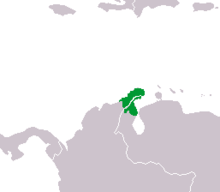Wayuu language
| Wayuu | |
|---|---|
| Wayuunaiki | |
| Pronunciation | [wajunaiki] |
| Native to | Venezuela, Colombia |
| Ethnicity | Wayuu people |
Native speakers | 320,000 (2001–2007)[1] |
|
Arawakan
| |
| Latin script | |
| Official status | |
| Regulated by | Centro Etnoeducativo Kamusuchiwo’u |
| Language codes | |
| ISO 639-3 |
guc |
| Glottolog |
wayu1243[2] |
|
Extent of both the Wayuu people and language. | |
The Wayuu language, or Goajiro (Wayuu: Wayuunaiki), is spoken by 305,000 indigenous Wayuu people in northwestern Venezuela and northeastern Colombia on the Guajira Peninsula.
Wayuu is one of the major Arawakan languages. There are minimal differences depending on the region of La Guajira in which speakers live. Most of the younger generations speak Spanish fluently. The extinct Guanebucan language may actually have been a dialect of Wayuu.
To promote cultural integration and bilingual education among Wayuu and other Colombians, the Kamusuchiwo’u Ethno-educative Center or Centro Etnoeducativo Kamusuchiwo’u came up with the initiative of creating the first illustrated Wayuunaiki–Spanish, Spanish–Wayuunaiki dictionary.[3]
Less than 1% of Wayuu speakers are literate in Wayuu while 5 to 15% are literate in Spanish. There are 200,000 speakers in Venezuela and 120,000 in Colombia. Smith (1995) reports that a mixed Guajiro-Spanish language is replacing Wayuu in both countries. However, Campbell (1997) could find no information on this.
Recent developments
In December 2011, the Wayuu Tayá Foundation and Microsoft presented the first ever dictionary of technology terms in the Wayuu language,[4][5] after having developed it for three years with a team of technology professionals and linguists.
Sounds
Vowels
| Front | Central | Back | |
|---|---|---|---|
| Close | i [i] | ü [ɨ] | u [u] |
| Mid | e [ɛ] | o [ɔ] | |
| Open | a [a] |
Note: "e" and "o" are more open than in English. "a" is slightly front of central, and "ü" is slightly back of central.
Consonants
| Labial | Alveolar | Palatal | Velar | Glottal | |
|---|---|---|---|---|---|
| Nasal | m [m] | n [n] | |||
| Plosive | p [p] | t [t̪] | ch [t͡ʃ] | k [k] | ' [ʔ] |
| Fricative | s [s] | sh [ʃ] | j [ɨ] | ||
| Flap | l [ɺ] | ||||
| Trill | r [ɾ] | ||||
| Approximant | w [w] | y [j] |
"l" is a lateral flap pronounced with the tongue just behind the position for the Spanish "r," and with a more lateral airflow.
Grammar
The personal pronouns are:[6]
| singular | plural | |
|---|---|---|
| 1st person | taya | waya |
| 2nd person | pia | jia (hia) |
| 3rd person | nia (he)
shia (she) |
naya |
Notes
- ↑ Wayuu at Ethnologue (18th ed., 2015)
- ↑ Hammarström, Harald; Forkel, Robert; Haspelmath, Martin; Bank, Sebastian, eds. (2016). "Wayuu". Glottolog 2.7. Jena: Max Planck Institute for the Science of Human History.
- ↑ (Spanish) El Wayuunaiki impreso
- ↑ Fundación Wayuu Tayá y Microsoft Venezuela presentan Diccionario de Computación en Wayuunaiki (Spanish)
- ↑ Tatiana Chang (2011-12-27). "Venezuela: New computing dictionary enriches Wayuu language". Infosur hoy. Retrieved 2012-08-05.
- ↑ Mansen, Kais and Mansen, Richard. Aprendamos Guajiro. http://www-01.sil.org/americas/colombia/pubs/capitulo%2002_Guajiro.pdf
External links
| Wayuu language test of Wikipedia at Wikimedia Incubator |
| Wayuu language test of Wiktionary at Wikimedia Incubator |
- WayuuTribe.com -About the Wayuu People and Wayuu Art
 Media related to Wayuu language at Wikimedia Commons
Media related to Wayuu language at Wikimedia Commons- Brief explanation of the Wayuunaiiki language
- Spanish-Wayuunaiki dictionary
- Venezuelanalysis.com, 4 August 2010, Venezuelan history first - Wayuunaiki newspaper wins Venezuelan journalism award
